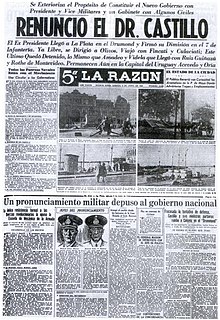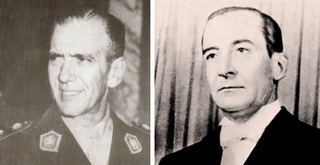 W
WThe 1930 Argentine coup d'état, also known as the September Revolution by its supporters, involved the overthrow of the Argentine government of Hipólito Yrigoyen by forces loyal to General José Félix Uriburu. The coup took place on 6 September 1930 when Uriburu led a small detachment of troops into the capital, experiencing no substantial opposition and taking control of the Casa Rosada. Large crowds formed in Buenos Aires in support of the coup. Uriburu's forces took control of the capital and arrested Radical Civic Union supporters. There were no casualties in the coup.
 W
WThe 1943 Argentine coup d'état, also known as the Revolution of '43, was a coup d'état on 4 June 1943 that ended the government of Ramón Castillo, who had been fraudulently elected to the office of vice-president before succeeding to the presidency in 1942 as part of the period known as the Infamous Decade. The military was opposed to Governor Robustiano Patrón Costas, Castillo's hand-picked successor, a major landowner in Salta Province and a primary stockholder in the sugar industry. The only serious resistance to the military coup came from the Argentine Navy, which confronted the advancing army columns at the Navy Petty-Officers School of Mechanics.
 W
WArgentine Revolution was the name given by its leaders to a military coup d'état which overthrew the government of Argentina in June 1966 and began a period of military dictatorship by a junta from then until 1973.
 W
WThe Argentine Revolution of 1893, or the Radical Revolution of 1893, was a failed insurrection by members of the Radical Civic Union (UCR) against the government of Argentina, then controlled by the National Autonomist Party (PAN). It continued the goals of the Revolution of the Park of 1890, whose themes were further echoed in the Revolution of 1905.
 W
WThe Argentine War of Independence was fought from 1810 to 1818 by Argentine patriotic forces under Manuel Belgrano, Juan José Castelli and José de San Martín against royalist forces loyal to the Spanish crown. On July 9, 1816, an assembly met in San Miguel de Tucumán, declared full independence with provisions for a national constitution.
 W
WThe Decembrist revolution was a military coup in the Buenos Aires Province, Argentina. Juan Lavalle, returning with the troops that fought in the Argentine-Brazilian War, performed a coup on December 1, 1828, capturing and killing the governor Manuel Dorrego and ultimately closing the legislature. The rancher Juan Manuel de Rosas organized militias that fought against Lavalle and removed him from power, restoring the legislature. However, as the coup had reignited the Argentine Civil Wars, Rosas was appointed governor of the Buenos Aires province to wage the war against the Unitarian League. José María Paz made from Córdoba a league of provinces, and so did Rosas. The conflict ended a short time after the unexpected capture of Paz, who mistook enemy troops for his own.
 W
WThe May Revolution was a week-long series of events that took place from May 18 to 25, 1810, in Buenos Aires, capital of the Viceroyalty of the Río de la Plata. This Spanish colony included roughly the territories of present-day Argentina, Bolivia, Paraguay, Uruguay, and parts of Brazil. The result was the removal of Viceroy Baltasar Hidalgo de Cisneros and the establishment of a local government, the Primera Junta, on May 25. The junta would eventually become the country of Argentina. It was the first successful revolution in the South American Independence process.
 W
WRevolución Libertadora is the coup d'état that ended the second presidential term of Juan Perón in Argentina, on 16 September 1955.
 W
WThe Revolution of the Park, also known as the Revolution of '90, was an uprising against the national government of Argentina that took place on July 26, 1890, and started with the takeover of the Buenos Aires Artillery Park. It was led by members of the Civic Union against the presidency of Miguel Juárez Celman. Though it failed in its main goals, the revolution forced Celman's resignation and marked the decline of the elite of the Generation of '80.